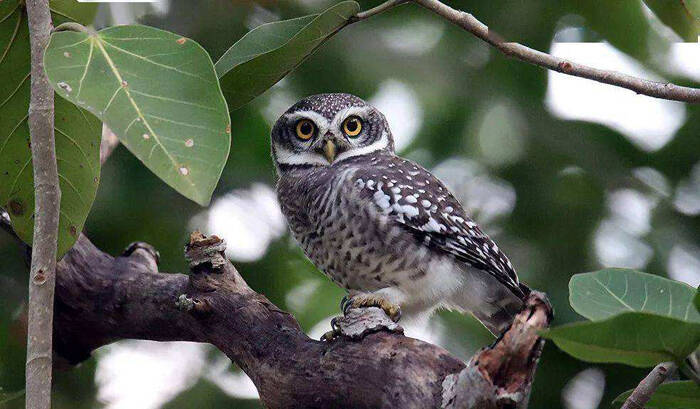Athene brama
IUCN
LCBasic Information
Scientific classification
- name:Athene brama
- Scientific Name:Athene brama,Spotted Owlet
- Outline:Raptor
- Family:Strigiformes Owl
Vital signs
- length:20-26cm
- Weight:100-185g
- lifetime:About 10-20 years
Feature
The lower body is gray, without stripes, and has horizontal stripes on both flanks, hence the name, but the middle of the abdomen is pure white, without stripes.
Distribution and Habitat
Resident bird: Iran.
Breeding place: Bangladesh, Bhutan, Cambodia, India, Laos, Myanmar, Nepal, Pakistan, Thailand and Vietnam.
In China, it is only distributed in Baoxing and Yajiang in Sichuan. It may also be distributed in southwestern Yunnan and southeastern Tibet, but it has yet to be confirmed. The barred little owl has also been found in Baoshan, Shanghai.
It lives in open or semi-open areas, low mountains and hills, forest edge shrubs and plain forest areas, including semi-deserts. It also appears in woods and ruins with ancient trees near farmlands, villages and suburbs. This species avoids dense forests. The living altitude is about 1,400 meters above sea level, and can reach up to 1,500 meters. It often lives on the top of large trees or on electric poles on barren slopes and farmland.
Appearance
Male and female barred-bellied owls have similar feather colors, but the female is usually larger than the male. The eyes are white at first, with black feathers and whiskers. The upper part of the eyes is white, forming two eyebrow lines and connecting into a "V" shaped spot on the forehead. The ear feather skin is yellowish-brown with white feather trunk lines, and the eye area is also white. The upper body is roughly dark sandy brown, the head is slightly darker with light yellow feather stripes, the tip is swollen into a drop shape, and the rest has round brown and white spots. The spots are larger on the back neck and upper back, forming a less obvious "V" "Type collar spot. There are white spots on the wing coverts and back. The white spots on the middle coverts and large coverts are larger and mostly oval. The flight feathers are brown, with brown-white spots on the outer feathers, large white round spots on the inner feathers and gray-white end spots. T
Details
Spotted Owlet, also known as Spotted Owlet, has 5 subspecies.

Spotted Owlet often moves alone or in pairs, roosting in tree holes or branches during the day, and can roost in pairs or small groups. It is mainly active at night. Flying quickly, the flight is very choppy, including some rapid wing spreads, followed by gliding, with the wings pressed against the body. It often catches food by waiting and quickly pursuing. It hunts mainly at dusk and at night, but can sometimes be seen during the day. It often waits quietly on the top of a tree or electric pole in an open area, waiting for prey to appear on the ground nearby or fly low over it, and then suddenly attacks from a high position to hunt. Occasionally catches insects in flight. It often uses street lights as a hunting base to prey on insects attracted by the lights. It mainly feeds on rodents and coleoptera insects, and also preys on small birds, lizards, frogs and other small animals.
The call of the Barred Owl is a hoarse and piercing "chirurrr-chirurrr-chirurrr" followed by "cheevak, cheevak, cheevak". It also makes noisy and incoherent screams and laughter-like sounds.
The breeding season of the Little Owl is from February to April for the northern population and from November to March of the following year for the southern population. The nests are built in natural tree holes or in the walls and building cavities of human residences. When suitable trees for nesting are scarce, nests may also be built in caves on both sides of gullies and earth cliffs. Sometimes they like to lay grass leaves and feathers in the nest. Each nest lays 3-5 eggs, which are round or oval in shape and 29-33 mm × 25-28 mm in size, with an average of 32.2 mm × 27 mm. Incubation begins after the first egg is laid. This results in asynchronous hatching of the chicks, and there is considerable difference in the size of the chicks during the brooding period. The female bird incubates the eggs.
The global population size of the Little Owl has not been quantified, but the species is reported to be common throughout most of its range. Trends confirmed: The species population is considered stable without any evidence of decline or major threats.
Listed in the IUCN Red List of Threatened Species 2016 ver3.1 - Least Concern (LC).
Listed in Appendix I, II and III of the Convention on International Trade in Endangered Species of Wild Fauna and Flora (CITES) 2019 edition Appendix II.
Listed in China's "National Key Protected Wildlife List" (February 5, 2021) Level 2.
Protect wildlife and eliminate game.
Maintaining ecological balance is everyone's responsibility!








